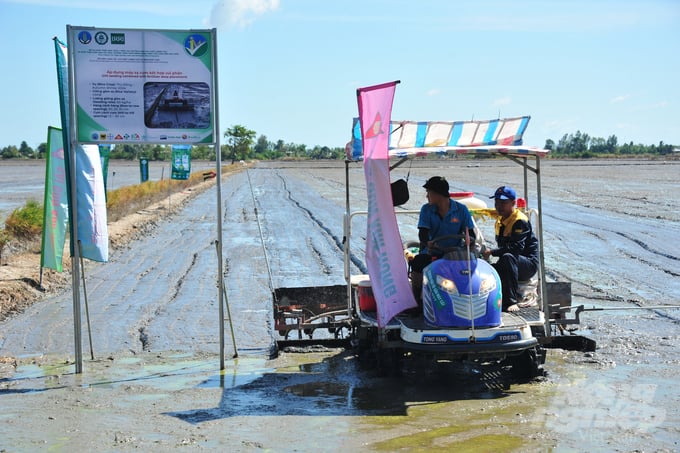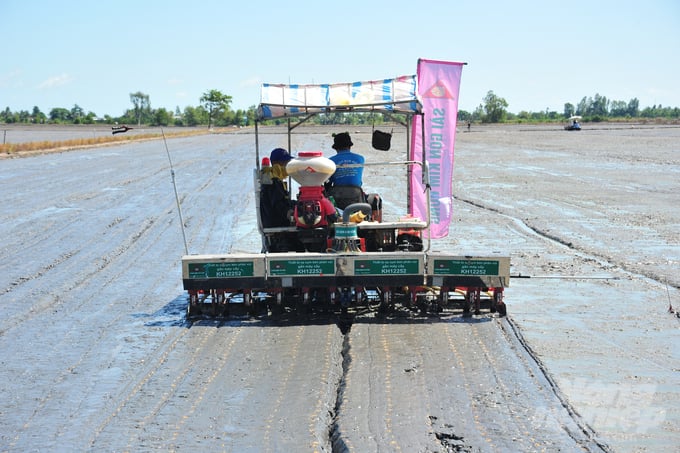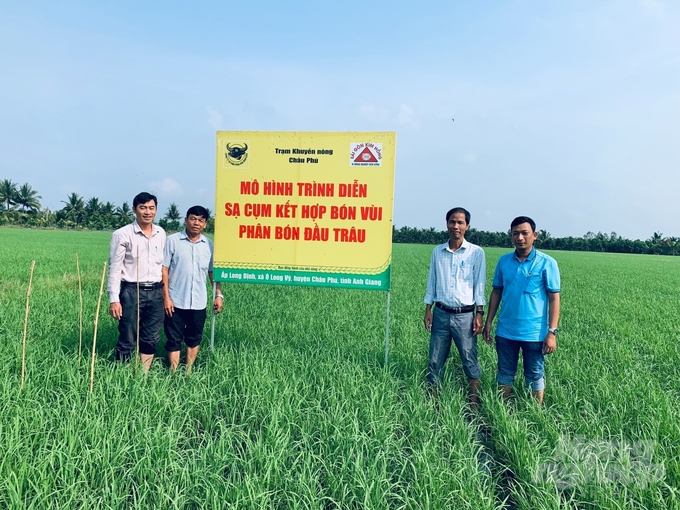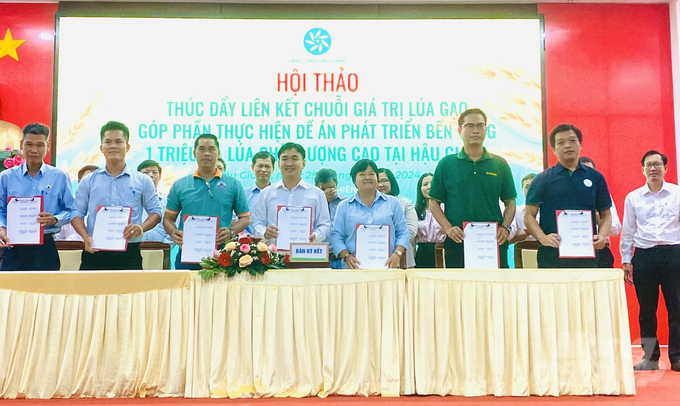May 31, 2025 | 13:01 GMT +7
May 31, 2025 | 13:01 GMT +7
Hotline: 0913.378.918
May 31, 2025 | 13:01 GMT +7
Hotline: 0913.378.918

Farmers from Hamlet 4, Lang Bien Commune, Thap Muoi District, Dong Thap Province have deployed cluster sowing and fertilizer-burying equipment, provided by Sai Gon Kim Hong Company, in their rice fields. Photo: Le Hoang Vu.
The cluster sowing machine, in combination with buried fertilization, can significantly enhances the rice production process for farmers. This mechanization solution is an efficient seeding method that represents a dual technological advancement. Accordingly, it promotes labor productivity and enhances biological yields. Furthermore, the adoption of the cluster sowing machine accurately represents the goal of the Sustainable Development Project for one million hectares of specialized, low-emission high-quality rice in the Mekong Delta.
During the 2024 summer-autumn crop cycle, farmers from Phuoc Hao Cooperative (Phuoc Hao Commune, Chau Thanh District, Tra Vinh Province) utilized the cluster sowing technology in a pilot model under the Sustainable Development Project for one million hectares of high-quality rice. The project continued into the 2024 autumn-winter crop cycle in Dong Thap Province with Thang Loi Cooperative (Lang Bien Commune, Thap Muoi District) and Kien Giang Province with Phu Hoa Youth Agricultural Service Cooperative (Tan Hoi Commune, Tan Hiep District).
Accordingly, the high-quality production model in Tra Vinh Province spanned 50 hectares. Local farmers utilized ST24 rice variety in combination with Con Voi - Binh Duong organic fertilizer. Similarly, the model in Dong Thap covered 24.5 hectares with OM18 rice variety using Dau Trau fertilizer. The model in Kien Giang covered over 18 hectares with the Dai Thom 8 rice variety and Binh Dien II fertilizer.
These models follow high-quality, low-emission rice production standards designed for the conditions of the Mekong Delta. Consequently, they meet the requirements set by the Prime Minister’s approved Project.

With the Sai Gon Kim Hong cluster sowing machine, farmers limited seeding rates to only 60 kilograms per hectare in Tra Vinh and 70 kilograms per hectare in Dong Thap and Kien Giang, resulting in an average seed usage rate of 64.6 kilograms per hectare. This rate is lower than the standard broadcast seeding rate of 81 kilograms per hectare, representing a 55.7% reduction in seed usage. Photo: Le Hoang Vu.
The Department of Crop Production and other agencies under the Ministry of Agriculture and Rural Development, in collaboration with local governments, inspected and evaluated the model sites in Tra Vinh, Dong Thap, and Kien Giang. Evaluations confirmed the substantial results at these model sites; notably, they have met technical metrics and even surpassed all project criteria.
Accordingly, the machines allowed farmers to reduce their seeding rates to 60 kilograms per hectare in Tra Vinh and 70 kilograms per hectare in Dong Thap and Kien Giang, resulting in an average seed usage rate of 64.6 kilograms per hectare. This rate is lower than the standard broadcast seeding rate of 81 kilograms per hectare, resulting in a 55.7% reduction in seed usage. Furthermore, these figures meet the project’s target of reducing seeding rates to below 70 kilograms per hectare by 2030. Additionally, the wider row spacing reduced the crop's demand for nutrient. As a result, the model used only 144 to 147 kilograms per hectare of N, P2O5, and K2O (in Tra Vinh and Kien Giang) and 177 kilograms per hectare (in Dong Thap), resulting in an average fertilizer usage rate of 153 kilograms per hectare. This rate is 97.4 kilograms per hectare lower than that of traditional production practices, representing a 38.9% reduction fertilizer use.
For nitrogen fertilizer, the model sites utilized 66 to 67 kilograms per hectare (in Kien Giang and Tra Vinh) and up to 80 kilograms per hectare (in Dong Thap), resulting in an average usage rate of 70.2 kilograms per hectare. This rate is 57.6 kilograms per hectare lower than that of traditional production, a 45.1% reduction in nitrogen use.
The number of pesticide applications also dropped due to the wider spacing, sufficient light exposure, and reduced fertilizer use. The model required only 5 applications in Tra Vinh, 6 in Kien Giang, and 7 in Dong Thap, averaging 5.7 applications per crop cycle, which is 2.6 fewer than the standard rate of 8.3, representing a reduction of 31.2%. Consequently, the Tra Vinh model received a certification for meeting VietGAP standards. Its products are priced 350 VND per kilogram higher than that of other rice in the area.
Production costs ranged from 18,059,000 to 18,712,000 VND per hectare in Dong Thap and Kien Giang, while costs reached over 22,380,000 VND per hectare in Tra Vinh, resulting in an average of 20,521,746 VND per hectare. This represents a reduction of 3,097,486 VND per hectare, or 13.1%, in production costs. Accordingly, these models have achieved significant results, despite the rapidly rising prices of agricultural inputs.

The cluster sowing machine features a higher work capacity, which can cover 6 to 10 hectares per day depending on the model, compared to the 3 to 4 hectares per day achieved by transplanting machines. This accelerated speed allows for synchronized planting schedules, thereby helping farmers avoid brown planthopper infestations, which is an essential requirement for rice production in the Mekong Delta. Photo: Le Hoang Vu.
The challenging weather conditions during the late summer-autumn crop cycle and throughout the autumn-winter crop, which featured sparse but intense rains accompanied by storms and strong winds, have negatively affected crop tending and harvesting efforts. However, farmers's strict compliance with the timely production directives has resulted in stable yields. Accordingly, rice yields reached 4.68 tons per hectare in Kien Giang, 5.88 tons per hectare in Dong Thap, and 6.6 tons per hectare in Tra Vinh, resulting in an average yield of 6.1 tons per hectare. These figures represented an increase of 5.3% over the region’s average yield.
Regarding profit and profit margin: With an average yield increase of 5.3% and a reduction of 13.1% in production costs compared to traditional farming practices, profits ranged from 20,732,000 VND per hectare in Kien Giang, 32,852,554 VND per hectare in Dong Thap, to 45,570,000 VND per hectare in Tra Vinh, resulting in an average profit of 37,368,255 VND per hectare. These figures represent an increase of 20.9% compared to the regional average. On the other hand, the models achieved a profit margin of 64.6%, which exceeded the project’s target of 50%.
Production cost: Production costs per kilogram of rice reached 2,941 VND in Dong Thap, 3,391 VND in Tra Vinh, and 3,998 VND in Kien Giang, resulting in an average cost of 3,362 VND per kilogram. These figures represent a reduction of 713 VND per kilogram, or 17.5%, compared to the regional average.
Emission reduction: The model sites recorded varying emission levels, namely 5.36 tons CO₂eq/ha in Tra Vinh, 6 tons CO₂eq/ha in Kien Giang, and 6.41 tons CO₂eq/ha in Dong Thap, with an average of 5.76 tons CO₂eq/ha. These figures represent a decrease of 54.8% compared to the average of 6.99 tons CO₂eq/ha. Notably, each model site conducted three field drainings per crop, with Tra Vinh recording the lowest emissions due to reduced fertilizer use.

Cluster sowing fields, with assistance from Sai Gon Kim Hong Company. Photo: Le Hoang Vu.
Representatives from the Ministry of Agriculture and Rural Development, local governments, and rice farmers have highly praised these results at evaluation conferences. Notably, the pilot models in Tra Vinh, Dong Thap, and Kien Giang have all met the project's technical requirements.
These achievements have also highlighted that high economic returns in rice production and sustainable rice farming are possible if stakeholders apply the technical package, including seed selection, nutrient management, pest control, and cultivation methods, in a consistent and exhaustive manner.
Reducing seed rates has emerged as the essential and most impactful component of the comprehensive technical package for enhancing rice production. Accordingly, the lower seed usage rate allows farmers to afford high-quality seeds. More importantly, this approach also reduces fertilizer and pesticide needs, lowers environmental pollution, improves rice productivity and quality, and reduces greenhouse gas emissions.
The initiative to reduce seeding rates has been an established solution within the agricultural sector. Furthermore, it is compatible with the broader strategy to enhance the mechanization of rice production, with a focus on mechanizing the sowing process. Mechanized sowing also supports seed reduction goals, leading to reduced fertilizer and pesticide use.
Consequently, rice transplanting machines became viable tools that support the goal of reducing seed usage rate. The promotion of mechanization within the sowing phase, facilitated by the implementation of transplanting machines, is essential in reducing seed consumption while minimizing the usage of fertilizers and pesticides.
However, despite the government's active support policies to minimize agricultural losses, such as Decisions 61, 63, 65, and 68, rice transplanting machines failed to gain widespread acceptance among farmers as an effective solution for the mechanization of the sowing process. The high investment costs of these machines, which require a wide range of compatible equipment (transplanters, soil levelers, seedling trays, nursery areas, etc.) for their operation, contribute to this reluctance. Consequently, these requirements increased the costs of seeding services compared to traditional sowing practices, which include additional cultivating and tending steps for seed trays.
Additionally, the soft and marshy conditions of many local fields prevent the efficient operation of transplanting machines. In contrast, cluster sowing machines can address these limitations effectively. As an alternative to investing in a complete set of cluster sowing equipment, farmers can afford a single functional component—specifically, the cluster sowing attachment—at a more manageable cost. Notably, this component can be integrated with commonly used land preparation machinery, such as large tractors or small tillers, which are already prevalent in the region. As a result, farmers can utilize these "modular machines" for land preparation as well as for sowing according to their needs, thereby effectively reducing initial capital investment while increasing the operational time of previously acquired equipment.

Dau Trau's model for cluster sowing in combination with organic fertilizer application in An Giang Province. Photo: Le Hoang Vu.
Cluster sowing machines forgo the complex and costly seedling-growing process, resulting in sowing costs that are only one-third of traditional transplanting practices. Furthermore, the cluster sowing equipment can connect with various machinery, offering compatibility with different tire types, sizes, and structures, enabling it to adapt to diverse terrain and soft, muddy fields where transplanting machines struggle due to lack of stability.
Moreover, cluster sowing machines feature a higher work capacity, which can cover 6 to 10 hectares per day depending on the model, compared to the 3 to 4 hectares per day achieved by transplanting machines. This accelerated speed allows for synchronized planting schedules, thereby helping farmers avoid brown planthopper infestations, which is an essential requirement for rice production in the Mekong Delta.
Additionally, the "black box" dispersal structure distributes seeds evenly across the field in both rows and clusters, unlike row sowing machines that only distribute seeds in single rows. This arrangement allows for optimal plant spacing, which supports enhanced growth by maximizing the edge effect—a crucial factor in promoting robust crop development.
Cluster sowing incorporates the technical benefits of transplanting and addresses the high-cost barrier and field limitations that have hindered transplanting on soft soils.
Conversely, the combination of cluster sowing with deep fertilization during the sowing process can further enhance the advantages of cluster sowing. Additionally, this approach reduces losses, particularly nitrogen fertilizer, which can evaporate or be washed away by surface water if flooding occurs shortly after application. Furthermore, the fertilizer can stimulate root growth in rice plants, thereby mitigating critical issues such as lodging, especially during the summer-autumn and autumn-winter crop cycles. This technique also enhances the rice plants' drought resistance, particularly during water shortages, saltwater intrusion, or irrigation deficiencies at the end of the winter-spring crop cycle.
Moreover, applying fertilizer adjacent to rice plant clusters facilitates the crop's access to nutrients, thereby reducing the loss of fertilizer to surrounding weeds. This strategic placement ultimately improves the efficiency of fertilizer utilization.
The cluster sowing machine, in combination with deep fertilization, allows for significant labor cost savings by eliminating the need for multiple surface fertilization applications. Notably, applying fertilizer simultaneously with sowing provides immediate and essential nutrients to the rice plants during their early growth stages. This practice promotes strong growth, early tillering, and concentrated tiller production, which are critical for rice fields utilizing cluster sowing techniques aimed at maximizing the number of tillers and panicles per square meter for optimal yields.
With these advantages, cluster sowing combined with deep fertilization can reduce fertilizer use by 20 to 30% compared to traditional broadcast fertilization methods.
The cluster sowing machine, especially when used in conjuction with deep fertilization, represents a critical achievement for rice production and an effective mechanized sowing solution. It boosts both labor productivity and crop productivity, which corresponds with the objectives of the national rice production project.

Dao Thi Nhu He, Director of Sai Gon Kim Hong Trading and Services Co., Ltd. (fifth from the left), signing a cooperation agreement to supply agricultural machinery for rice production as part of the provincial project with Hau Giang Province's Center for Agricultural Extension and Services. Photo: Le Hoang Vu.
With the distinct advantages of the cluster sowing solution in rice production, the cluster sowing machine has seen widespread adoption nationwide. The company has also exported cluster sowing machines to Cambodia, India, and with plans to ship them to the Philippines in the near future.
At present, Sai Gon Kim Hong distributes four main models of cluster sowing machines:
1. Cluster sowing in combination with transplanting: This model features a sowing width of 3.0 meters, with 12 rows spaced 25 centimeters apart, allowing for a sowing capacity of 6 to 8 hectares per day.
2. Cluster sowing equipment in combination with large tractors: This model features a sowing width ranging from 4.0 to 5.0 meters, accommodating 16 to 20 rows, also spaced 25 centimeters apart, allowing for a sowing capacity of 8 to 12 hectares per day.
3. Cluster sowing in combination with small tillers: This model features a sowing width of 3.0 meters, with 12 rows spaced 25 centimeters apart, allowing for a sowing capacity of 6 to 8 hectares per day.
4. Manual cluster sowing machine: This model features a sowing width of 2.0 meters, with 8 rows spaced 25 centimeters apart, allowing for a sowing capacity of 3 to 4 hectares per day. This model is particularly suitable for fields with weak soil and small plots.
Additionally, the above models (excluding the manual cluster sowing machine) can be equipped with integrated components for deep fertilization and seedling pest control, enabling them to function as "2-in-1" or "3-in-1" machines. All models can be adjusted on-site to switch from cluster sowing to row sowing by altering the distance between clusters to 2 to 3 centimeters and reducing the number of seeds per cluster to 3 to 4 seeds.
Translated by Nguyen Hai Long

(VAN) Several scientists and farmers are experimenting with soil treatment in some key durian-growing regions such as Cai Lay (Tien Giang), Dak Song, Gia Nghia, and Dak R’lap (Dak Nong).
/2025/05/25/4127-3-073637_820.jpg)
(VAN) Thanks to the promotion from an FAO-implemented project, vegetable production in greenhouses in Moc Chau has seen strong development, from 1.5 hectares in 2021 to nearly 50 hectares in 2024.

(VAN) FAO has recently supported USD 140,000 to implement the project 'Risk mitigation human-animal interface risks through disease control initiatives in pig farming.'

(VAN) The People's Committee of Tra Vinh province has approved an adjustment to the investment policy for the Green Hydrogen Plant project, increasing its area to approximately 52.76 hectares.
![Reducing emissions from rice fields: [2] Farmers’ commitment to the soil](https://t.ex-cdn.com/nongnghiepmoitruong.vn/608w/files/news/2025/05/05/dsc08881jpg-nongnghiep-140632.jpg)
(VAN) Clean rice cultivation model in Thuong Tan commune, Bac Tan Uyen district, is assisting local residents in achieving sustainable agriculture by substantially reducing costs, increasing productivity, and protecting the environment.

(VAN) At the conference to disseminate Resolution No. 68, AgriS introduced its digital agricultural ecosystem and reaffirmed its commitment to accompanying the Government in promoting private sector development and sustainable agriculture.

(VAN) 'Blue Ocean - Blue Foods' initiative is designed to restore marine ecosystems and establish sustainable livelihoods for local communities by cultivating a minimum of 1,000 hectares of cottonii seaweed in the first three years.